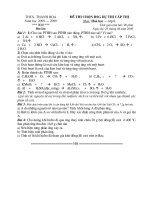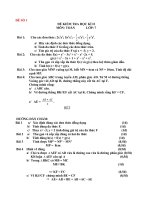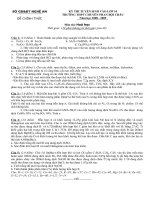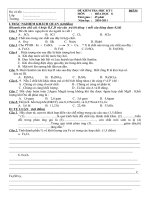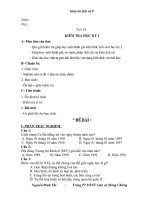- Trang chủ >>
- Đề thi >>
- Đề thi lớp 12
đề thi và đáp án olympic hóa học quốc tế icho 2017
Bạn đang xem bản rút gọn của tài liệu. Xem và tải ngay bản đầy đủ của tài liệu tại đây (5.51 MB, 108 trang )
Theoretical Problems
Grading Scheme
"Bonding the World with Chemistry"
49th INTERNATIONAL CHEMISTRY OLYMPIAD
Nakhon Pathom, THAILAND
Theoretical problems (official English version), 49th IChO 2017, Thailand
1
Problem 1
6% of the total
Problem 1
Total
Score
A
A1 A2 A3
4
1
2
B
C
7
6
Total
20
Problem 1: Production of propene using heterogeneous catalysts
Propene or propylene is one of the most valuable chemicals for the petrochemical
industry in Thailand and around the world. One good example of the commercial use of
propene is for the production of polypropylene (PP).
Part A.
Propene can be synthesized via a direct dehydrogenation of propane in the presence of
a heterogeneous catalyst. However, such a reaction is not economically feasible due to the
nature of the reaction itself. Provide a concise explanation to each of the questions below.
Additional information: Hbond(C=C) = 1.77Hbond(C-C), Hbond(H-H) = 1.05Hbond(C-H), and
Hbond(C-H) = 1.19Hbond(C-C), where Hbond refers to average bond enthalpy of the indicated
chemical bond.
1-A1) What is the enthalpy change of the direct dehydrogenation of propane? Show your
calculation and express your answer in terms of Hbond(C-C).
Calculation:
ΔHrxn = -{Hbond(C=C)+ Hbond(C-C)+ 6Hbond(C-H)+ Hbond(H-H)}
+{2Hbond(C-C)+8Hbond(C-H)}
(2 points)
= -{1.77Hbond(C-C)+ Hbond(C-C)+ 6(1.19Hbond(C-C)+ 1.05(1.19Hbond(C-C)}
+{2Hbond(C-C)+8(1.19Hbond(C-C)}
= +0.360Hbond(C-C)
(2 points)
Theoretical problems (official English version), 49th IChO 2017, Thailand
2
1-A2) It is difficult to increase the amount of propene by increasing pressure at constant
temperature. Which law or principle can best explain this phenomenon? Select your answer by
marking “” in one of the open circles.
⃝ Boyle’s law
⃝ Charles’ law
⃝ Dalton’s law
⃝ Raoult’s law
⃝
Le Chatelier’s principle
1-A3) Initially, the system is in equilibrium. Consistent with question 1-A1), what is/are correct
set(s) of signs for the following thermodynamic variables of the system for the direct
dehydrogenation of propane? Select your answer(s) by marking “” in any of the open
circle(s).
⃝
⃝
⃝
⃝
⃝
⃝
⃝
⃝
⃝
*
G T*
S
H
+
+
lower
+
higher
+
lower
higher
+
+
+
lower
+
+
higher
+
+
lower
+
higher
None of the above is correct
Relative to the initial temperature at the same partial pressure.
If a student provides a negative enthalpy in question 1-A1, full credit will be given if the
student selects the 2nd choice. If a student does not answer question 1-A1, he or she will still
get full credit if either the two choices indicated above or the 2nd choice are selected.
Theoretical problems (official English version), 49th IChO 2017, Thailand
3
Part B.
A better reaction to produce large quantity of propene is the oxidative dehydrogenation
(ODH) using solid catalysts, such as vanadium oxides, under molecular oxygen gas. Although
this type of reaction is still under intense research development, its promise toward the
production of propene at an industrial scale eclipses that of the direct dehydrogenation.
1-B) The overall rate of propane consumption in the reaction is rC3 H 8
1
,
p
p
k red pC H
k
p
ox O2
3 8
where kred and kox are the rate constants for the reduction of metal oxide catalyst by propane
and for the oxidation of the catalyst by molecular oxygen, respectively, and p is the standard
pressure of 1 bar. Some experiments found that the rate of oxidation of the catalyst is 100,000
pC H
times faster than that of the propane oxidation. The experimental rC3 H 8 k obs 3 8 at 600 K,
p
where kobs is the observed rate constant (0.062 mol s-1). If the reactor containing the catalyst is
continuously passed through with propane and oxygen at a total pressure of 1 bar, determine
the value of kred and kox when the partial pressure of propane is 0.10 bar. Assume that the partial
pressure of propene is negligible.
Calculation:
From the information given, the oxidation step is much faster than the propane
reduction. Thus,
1
1
.
k red pC3 H 8
k ox pO2
(1 point)
We then have rC3 H 8 k red pC3 H 8 .
(2 points)
Therefore, kobs = kred = 0.062 mol s-1.
(1 point)
Since k ox pO2 100,000kred pC3 H 8 ,
(1 point)
k ox 100,000(0.062 mol s )(0.10)/(0.90) 6.9 10 mol s .
-1
2
-1
(2 points)
[Deduction of 1 point for incorrect unit(s). In any case, the total point for this
question cannot be negative.]
Theoretical problems (official English version), 49th IChO 2017, Thailand
4
Part C.
The metal oxide catalyst contains oxygen atoms on its surface that serve as active sites
for the ODH. Denoting red* as a reduced site and O(s) as an oxygen atom on the surface of the
catalyst, one of the proposed mechanisms for the ODH in the presence of the catalyst can be
written as follows:
k1
C3H8(g) + O(s)
C3H6(g) + H2O(g) + red*
(1)
k2
C3H6(g) + 9O(s)
3CO2(g) + 3H2O(g) + 9red*
(2)
k3
O2(g) + 2red*
2O(s)
(3)
Given
number of reduced sites
, the rate laws for the above 3 steps are:
total number of active sites
r1 k1 pC3 H 8 (1 ) ,
r2 k 2 pC3 H 6 (1 ) ,
and r3 k 3 pO2 .
1-C) Assuming that the amount of oxygen atoms on the surface stays constant at any time of
reaction, calculate as a function of k1, k2, k3, p C3 H 8 , p C3 H 6 , and pO2 .
Calculation:
Consumption of oxygen atoms in steps 1+2 = Production of oxygen atoms in step 3
r1 9r2 2r3
(3 points)
k1 pC3 H 8 (1 ) 9k 2 pC3 H 6 (1 ) 2k 3 pO2
(1 point)
k1 pC3 H 8 9k 2 pC3 H 6 (k1 pC3 H 8 9k 2 pC3 H 6 ) 2k 3 pO2
(k1 pC H 9k 2 pC H 2k 3 pO ) k1 pC H 9k 2 pC H
3
8
Thus,
3
6
2
k1 p C 3 H 8 9 k 2 p C 3 H 6
k1 pC3 H 8 9k 2 pC3 H 6 2k 3 pO2
3
8
3
6
.
Theoretical problems (official English version), 49th IChO 2017, Thailand
(2 points)
5
Problem 2
Problem 2
6% of the total
Total
Score
A
A1 A2 A3 A4 A5 A6 A7 A8
2
2
7
3
3
1
5
1
Total
24
Problem 2: Kinetic isotope effect (KIE) and zero-point vibrational energy (ZPE)
Calculation of ZPE and KIE
Kinetic isotope effect (KIE) is a phenomenon associated with a change in rate constant
of the reaction when one of the atoms is replaced by its isotope. KIE can be used to confirm
whether a particular bond to hydrogen is broken in the reaction. Harmonic oscillator model is
used to estimate the difference in the rate between C-H and C-D bond activation (D = 21H).
The vibrational frequency () represented by harmonic oscillator model is
1
2
k
,
where k is the force constant and is the reduced mass.
The vibrational energies of the molecule are given by
1
En n h ,
2
where n is vibrational quantum number with possible values of 0, 1, 2, ... The energy of the
lowest vibrational energy level (En at n= 0) is called zero-point vibrational energy (ZPE).
2-A1) Calculate the reduced mass of C-H (CH) and C-D (CD) in atomic mass unit. (2 points)
Assume that the mass of deuterium is twice that of hydrogen.
Calculation:
Full credit will also be given using mH = 1.00 amu, mD = 2.014 or 2.00 amu.
CH
mC mH
(12 .01)(1.008 )
mC mH 12 .01 1.008
12.11
0.9299 amu
13.02
(0.5 point)
(0.5 point)
If the answer is not in atomic mass unit, 0.5 point will be deducted.
CD
mC mD
(12 .01)(2 1.008 )
mC mD 12 .01 (2 1.008 )
24.21
1.726 amu
14.03
(0.5 point)
(0.5 point)
If the answer is not in atomic mass unit, 0.5 point will be deducted.
Theoretical problems (official English version), 49th IChO 2017, Thailand
6
[If students are unable to calculate the values for CH and CD in 2-A1), use CH = 1.008 and
CD = 2.016 for the subsequent parts of the question. Note that the given values are not
necessarily close to the correct values.]
2-A2) Given that the force constant (k) for C-H stretching is the same as that for the C-D
stretching and the C-H stretching frequency is 2900 cm-1, find the corresponding C-D
stretching frequency (in cm-1). (2 points)
Calculation:
1. Use the correct reduced mass.
CH
1
2
CD
1
2
νCH
νCD
νCD
k
CH
k
CD
μCD
1.726
1.856 1.362
μCH
0.9299
(1 point)
νCH
2900
2129 cm -1
1.362 1.362
(1 point)
2. Use the reduced mass given.
νCH
νCD
νCD
μCD
μCH
2.016
2.000 1.414
1.008
(1 point)
νCH
2900
2051 cm -1
1.414 1.414
Alternatively, full credit is given when students use CH
(1 point)
1
2
k
CH
to evaluate
force constant, then use the force constant to calculate CD . In this case, if the CD is
wrong, but the force constant k is correct, only 1 point will be given.
Theoretical problems (official English version), 49th IChO 2017, Thailand
7
2-A3) According to the C-H and C-D stretching frequencies in question 2-A2, calculate the
zero-point vibrational energies (ZPE) of C-H and C-D stretching in kJ mol-1. (7 points)
Calculation:
1
En n h , n 0, 1, 2, ...
2
1
(1 point)
ZPE E n0 h
2
1
ZPECH h CH
2
1
(6.6261 10-34 J s)(2900 cm-1 )(2.9979 1010 cm s -1 )(6.0221 1023 mol -1 )(10-3 kJ)
2
17.35 kJ mol -1
(3 points)
If either calculation error or wrong unit is found, 0.5 point will be deducted.
If one of the conversion factors is missing, 1 point will be deducted.
If one of the conversion factors is missing and either calculation error or wrong unit is
found, 1.5 points will be deducted.
If two of the conversion factors are missing, 2 points will be deducted.
If two of the conversion factors are missing and either calculation error or wrong unit is
found, 2.5 points will be deducted.
Either 1. or 2. below is accepted.
1. Use the correct reduced mass.
1
ZPECD h CD
2
1
(6.6261 10-34 J s)(2129 cm-1 )(2.9979 1010 cm s -1 )(6.0221 1023 mol -1 )(10-3 kJ)
2
12.73 kJ mol -1
(3 points)
2. Use the given reduced mass.
1
ZPECD h CD
2
1
(6.6261 10-34 J s)(2051cm-1 )(2.9979 1010 cm s -1 )(6.0221 1023 mol -1 )(10-3 kJ)
2
12.27 kJ mol -1
(3 points)
If either calculation error or wrong unit is found, 0.5 point will be deducted.
If one of the conversion factors is missing, 1 point will be deducted.
If one of the conversion factors is missing and either calculation error or wrong unit is
found, 1.5 points will be deducted.
If two of the conversion factors are missing, 2 points will be deducted.
If two of the conversion factors are missing and either calculation error or wrong unit is
found, 2.5 points will be deducted.
Theoretical problems (official English version), 49th IChO 2017, Thailand
8
[If students are unable to calculate the values for ZPE in 2-A3), use ZPECH = 7.23 kJ/mol and
ZPECD = 2.15 kJ/mol for the subsequent parts of the question. Note that the given values are
not necessarily close to the correct values.]
Kinetic isotope effect (KIE)
Due to the difference in zero-point vibrational energies, a protonated compound and its
corresponding deuterated compounds are expected to react at different rates.
For the C-H and C-D bond dissociation reactions, the energies of both transition states
and both products are identical. Then, the isotope effect is controlled by the difference in the
ZPE's of the C-H and C-D bonds.
2-A4) Calculate the difference in the bond dissociation energy (BDE) between C-D bond and
C-H bond ( BDECD BDECH ) in kJ mol-1. (3 points)
Calculation:
From the ZPECH and ZPECD in question 2-A3),
1. Use the correct reduced mass.
BDECD BDECH ZPE CH ZPE CD
(1.5 point)
17.35 - 12.73 kJ mol -1
4.62 kJ mol -1
(1.5 point)
2. Use the given reduced mass.
BDECD BDECH ZPE CH ZPE CD
(1.5 point)
17.35 - 12.27 kJ mol -1
5.08 kJ mol -1
3. Use the given ZPE.
BDECD BDECH ZPE CH ZPE CD
(1.5 point)
(1.5 point)
7.23 - 2.15 kJ mol -1
5.08 kJ mol -1
(1.5 point)
The answer calculated from BDECD BDECH ZPECD ZPECH will be given only 1
point for question 2-A4).
Theoretical problems (official English version), 49th IChO 2017, Thailand
9
2-A5) Assume that the activation energy (Ea) for the C-H/C-D bond cleavage is approximately
equal to the bond dissociation energy and the Arrhenius factor is the same for both C-H and
C-D bond cleavage. Find the relative rate constant for the C-H/C-D bond cleavage (kCH/kCD) at
25 oC. (3 points)
Calculation:
1. Use the correct reduced mass.
kCH
e ( ZPECD ZPECH ) / RT
kCD
e-( -4.6210 J mol )/( 8.3145J K
= e1.86 = 6.45
3
-1
(1 point)
-1
mol-1 )( 25273.15K)
2. Use the given reduced mass or the given ZPE.
kCH
e ( ZPECD ZPECH ) / RT
kCD
e-( -5.0810 J mol
= e2.05 = 7.77
3
-1
)/( 8.3145J K -1 mol-1 )( 25273.15K)
The answer calculated from
(1 point)
(1 point)
(1 point)
(1 point)
(1 point)
kCH
e ( ZPECH ZPECD ) / RT will be given only 1 point for
kCD
question 2-A5).
[The answer must be consistent with the answer in question 2-A4).]
Using KIE to study reaction mechanism
The oxidation of nondeuterated and deuterated diphenylmethanol using an excess of
chromic acid was studied.
2-A6) Let C0 be the initial concentration of either nondeuterated diphenylmethanol or
deuterated diphenylmethanol and Ct its concentration at time t. The experiment led to two plots
(Figure 2a and Figure 2b), from which the first-order rate constant can be determined.
Theoretical problems (official English version), 49th IChO 2017, Thailand
10
1.00
0.90
0.90
0.80
0.80
0.70
0.70
ln (C0/Ct)
ln (C0/Ct)
1.00
0.60
0.50
0.40
0.60
0.50
0.40
0.30
0.30
0.20
0.20
0.10
0.10
0.00
0.00
0
100
200
300
Time / min
400
500
Figure 2a
0
15
30
45
Time / min
60
75
90
Figure 2b
Which plot should be for the oxidation of nondeuterated diphenylmethanol and which one is
for the oxidation of deuterated diphenylmethanol? (1 point)
For each statement, select your answer by marking “” in one of the open circles.
The oxidation of nondeuterated diphenylmethanol: ⃝ Figure 2a ⃝
Figure 2b
The oxidation of deuterated diphenylmethanol:
⃝
Figure 2a ⃝ Figure 2b
[1 point for 2 correct answers; 0.5 point for 1 correct answer; 0 point for 2 wrong answer;
0 point for 1 wrong & 1 correct answer]
[The answer must be consistent with the answer in question 2-A5).]
Theoretical problems (official English version), 49th IChO 2017, Thailand
11
2-A7) Determine kCH, kCD (in min-1), and the kCH/kCD of this reaction from the plots in question
2-A6. (5 points)
Calculation:
C
ln 0 kCH t
Ct
k CH 0.012
ln
C0
kCD t
Ct
min-1 (from the slope of the plot in Figure 2b)
(1 point)
(1.5 points)
0.70 0.35
0.012 min-1
60 30
[If kCH is calculated from the slope of the plot in Figure 2a, 1 point will be deducted.]
Example:
kCH
k CD 0.0018 min-1 (from the slope of the plot in Figure 2a)
(1.5 points)
0.70 0.35
0.0018 min-1
400 200
[If kCD is calculated from the slope of the plot in Figure 2b, 1 point will be deducted.]
Example:
kCD
k CH
0.012
6.7
k CD 0.0018
(1 point)
[The answer must be consistent with the answer in question 2-A6).]
2-A8) The mechanism has been proposed as follows:
According to the information in 2-A6) and 2-A7), which step should be the rate determining
step? (1 point)
Select your answer by marking “” in one of the open circles.
⃝ Step (1)
⃝ Step (2)
⃝
Step (3)
Theoretical problems (official English version), 49th IChO 2017, Thailand
12
Problem 3
Problem 3
Total
Score
6% of the total
A
A1 A2 A3
7
3
8
B
Total
6
24
Problem 3: Thermodynamics of chemical reactions
Part A.
Methanol is produced commercially by using a mixture of carbon monoxide and
hydrogen over zinc oxide/copper oxide catalyst:
CO(g) + 2H2(g) CH3OH(g).
The standard enthalpy of formation (Hfo) and the absolute entropy (So) for each of the three
gases at room temperature (298 K) and at a standard pressure of 1 bar are given as follows.
Gas
Hfo (kJ mol-1)
So (J K-1 mol-1)
CO(g)
H2(g)
CH3OH(g)
-111
0
-201
198
131
240
3-A1) Calculate Ho, So, Go, and Kp for the r��������������������������������������������������������������������������������������������������������������������������������������������������������������������������������������������������������������������������������������������������������������������������������������������������������������������������������������������������������������������������������������������������������������������������������������������������������������������������������������������������������������������������������������������������������������������������������������������������������������������������������������������������������������������������������������������������������������������������������������������������������������������������������������������������������������������������������������������������������������������������������������������������������������������������������������������������������������������������������������������������������������������������������������������������������������������������������������������������������������������������������������������������������������������������������������������������������������������������������������������������������������������������������������������������������������������������������������������������������������������������������������������������������������������������������������������������������������������������������������������������������������������������������������������������������������������������������������������������������������������������������������������������������������������������������������������������������������������������������������������������������������������������������������������������������������������������������������������������������������������������������������������������������������������������������������������������������������������������������������������������������������������������������������������������������������������������������������������������������������������������������������������������������������������������������������������������������������������������������������������������������������������������������������������������������������������������������������������������������������������������������������������������������������������������������������������������������������������������������������������������������������������������������������������������������������������������������������������������������������������������������������������������������������������������������������������������������������������������������������������������������������������������������������������������������������������������������������������������������������������������������������������������������������������������������������������������������������������������������������������������������������������������������������������������������������������������������������������������������������������������������������������������������������������������������������������������������������������������������������������������������������������������������������������������������������������������������������������������������������������������������������������������������������������������������������������������������������������������������������������������������������������������������������������������������������������������������������������������������������������������������������������������������������������������������������������������������������������������������������������������������������������������������������������������������������������������������������������������������������������������������������������������������������������������������������������������������������������������������������������������������������������������������������������������������������������������������������������������������������������������������������������������������������������������������������������������������������������������������������������������������������������������������������������������������������������������������������������������������������������������������������������������������������������������������������������������������������������������������������������������������������������������������������������������������������������������������������������������������������������������������������������������������������������������������������������������������������������������������������������������������������������������������������������������������������������������������������������������������������������������������������������������������������������������������������������������������������������������������������������������������������������������������������������������������������������������������������������������������������������������������������������������������������������������������������������������������������������������������������������������������������������������������������������������������������������������������������������������������������������������������������������������������������������������������������������������������������������������������������������������������������������������������������������������������������������������������������������������������������������������������������������������������������������������������������������������������������������������������������������������������������������������������������������������������������������������������������������������������������������������������������������������������������������������������������������������������������������������������������������������������������������������������������������������������������������������������������������������������������������������������������������������������������������������������������������������������������������������������������������������������������������������������������������������������������������������������������������������������������������������������������������������������������������������������������������������������������������������������������������������������������������������������������������������������������������������������������������������������������������������������������������������������������������������������������������������������������������������������������������������������������������������������������������������������������������������������������������������������������������������������������������������������������������������������������������������������������������������������������������������������������������������������������������������������������������������������������������������������������������������������������������������������������������������������������������������������������������������������������������������������������������������������������������������������������������������������������������������������������������������������������������������������������������������������������������������������������������������������������������������������������������������������������������������������������������������������������������������������������������������������������������������������������������������������������������������������������������������������������������������������������������������������������������������������������������������������������������������������������������������������������������������������������������������������������������������������������������������������������������������������������������������������������������������������������������������������������������������������������������������������������������������������������������������������������������������������������������������������������������������������������������������������������������������������������������������������������������������������������������������������������������������������������������������������������������������������������������������������������������������������������������������������������������������������������������������������������������������������������������������������������������������������������������������������������������������������������������������������������������������������������������������������������������������������������������������������������������������������������������������������������������������������������������������������������������������������������������������������������������������������������������������������������������������������������������������������������������������������������������������������������������������������������������������������������������������������������������������������������������������������������������������������������������������������������������������������������������������������������������������������������������������������������������������������������������������������������������������������������������������������������������������������������������������������������������������������������������������������������������������������������������������������������������������������������������������������������������������������������������������������������������������������������������������������������������������������������������������������������������������������������������������������������������������������������������������������������������������������������������������������������������������������������������������������������������������������������������������������������������������������������������������������������������������������������������������������������������������������������������������������������������������������������������������������������������������������������������������������������������������������������������������������������������������������������������������������������������������������������������������������������������������������������������������������������������������������������������������������������������������������������������������������������������������������������������������������������������������������������������������������������������������������������������������������������������������������������������������������������������������������������������������������������������������������������������������������������������������������������������������������������������������������������������������������������������������������������������������������������������������������������������������������������������������������������������������������������������������������������������������������������������������������������������������������������������������������������������������������������������������������������������������������������������������������������������������������������������������������������������������������������������������������������������������������������������������������������������������������������������������������������������������������������������������������������������������������������������������������������������������������������������������������������������������������������������������������������������������������������������������������������������������������������������������������������������������������������������������������������������������������������������������������������������������������������������������������������������������������������������������������������������������������������������������������������������������������������������������������������������������������������������������������������������������������������������������������������������������������������������������������������������������������������������������������������������������������������������������������������������������������������������������������������������������������������������������������������������������������������������������������������������������������������������������������������������������������������������������������������������������������������������������������������������������������������������������������������������������������������������������������������������������������������������������������������������������������������������������������������������������������������������������������������������������������������������������������������������������������������������������������������������������������������������������������������������������������������������������������������������������������������������������������������������������������������������������������������������������������������������������������������������������������������������������������������������������������������������������������������������������������������������������������������������������������������������������������������������������������������������������������������������������������������������������������������������������������������������������������������������������������������������������������������������������������������������������������������������������������������������������������������������������������������������������������������������������������������������������������������������������������������������������������������������������������������������������������������������������������������������������������������������������������������������������������������������������������������������������������������������������������������������������������������������������������������������������������������������������������������������������������������������������������������������������������������������������������������������������������������������������������������������������������������������������������������������������������������������������������������������������������������������������������������������������������������������������������������������������������������������������������������������������������������������������������������������������������������������������������������������������������������������������������������������������������������������������������������������������������������������������������������������������������������������������������������������������������������������������������������������������������������������������������������������������������������������������������������������������������������������������������������������������������������������������������������������������������������������������������������������������������������������������������������������������������������������������������������������������������������������������������������������������������������������������������������������������������������������������������������������������������������������������������������������������������������������������������������������������������������������������������������������������������������������������������������������������������������������������������������������������������������������������������������������������������������������������������������������������������������������������������������������������������������������������������������������������������������������������������������������������������������������������������������������������������������������������������������������������������������������������������������������������������������������������������������������������������������������������������������������������������������������������������������������������������������������������������������������������������������������������������������������������������������������������������������������������������������������������������������������������������������������������������������������������������������������������������������������������������������������������������������������������������������������������������������������������������������������������������������������������������������������������������������������������������������������������������������������������������������������������������������������������������������������������������������������������������������������������������������������������������������������������������������������������������������������������������������������������������������������������������������������������������������������������������������������������������������������������������������������������������������������������������������������������������������������������������������������������������������������������������������������������������������������������������������������������������������������������������������������������������������������������������������������������������������������������������������������������������������������������������������������������������������������������������������������������������������������������������������������������������������������������������������������������������������������������������������������������������������������������������������������������������������������������������������������������������������������������������������������������������������������������������������������������������������������������������������������������������������������������������������������������������������������������������������������������������������������������������������������������������������������������������������������������������������������������������������������������������������������������������������������������������������������������������������������������������������������������������������������������������������������������������������������������������������������������������������������������������������������������������������������������������������������������������������������������������������������������������������������������������������������������������������������������������������������������������������������������������������������������������������������������������������������������������������������������������������������������������������������������������������������������������������������������������������������������������������������������������������������������������������������������������������������������������������������������������������������������������������������������������������������������������������������������������������������������������������������������������������������������������������������������������������������������������������������������������������������������������������������������������������������������������������������������������������������������������������������������������������������������������������������������������������������������������������������������������������������������������������������������������������������������������������������������������������������������������������������������������������������������������������������������������������������������������������������������������������������������������������������������������������������������������������������������������������������������������������������������������������������������������������������������������������������������������������������������������������������������������������������������������������������������������������������������������������������������������������������������������������������������������������������������������������������������������������������������������������������������������������������������������������������������������������������������������������������������������������������������������������������������������������������������������������������������������������������������������������������������������������������������������������������������������������������������������������������������������������������������������������������������������������������������������������������������������������������������������������������������������������������������������������������������������������������������������������������������������������������������������������������������������������������������������������������������������������������������������������������������������������������������������������������������������������������������������������������������������������������������������������������������������������������������������������������������������������������������������������������������������������������������������������������������������������������������������������������������������������������������������������������������������������������������������������������������������������������������������������������������������������������������������������������������������������������������������������������������������������������������������������������������������������������������������������������������������������������������������������������������������������������������������������������������������������������������������������������������������������������������������������������������������������������������������������������������������������������������������������������������������������������������������������������������������������������������������������������������������������������������������������������������������������������������������������������������������������������������������������������������������������������������������������������������������������������������������������������������������������������������������������������������������������������������������������������������������������������������������������������������������������������������������������������������������������������������������������������������������������������������������������������������������������������������������������������������������������������������������������������������������������������������������������������������������������������������������������������������������������������������������������������������������������������������������������������������������������������������������������������������������������������������������������������������������������������������������������������������������������������������������������������������������������������������������������������������������������������������������������������������������������������������������������������������������������������������������������������������������������������������������������������������������������������������������������������������������������������������������������������������������������������������������������������������������������������������������������������������������������������������������������������������������������������������������������������������������������������������������������������������������������������������������������������������������������������������������������������������������������������������������������������������������������������������������������������������������������������������������������������������������������������������������������������������������������������������������������������������������������������������������������������������������������������������������������������������������������������������������������������������������������������������������������������������������������������������������������������������������������������������������������������������������������������������������������������������������������������������������������������������������������������������������������������������������������������������������������������������������������������������������������������������������������������������������������������������������������������������������������������������������������������������������������������������������������������������������������������������������������������������������������������������������������������������������������������������������������������������������������������������������������������������������������������������������������������������������������������������������������������������������������������������������������������������������������������������������������������������������������������������������������������������������������������������������������������������������������������������������������������������������������������������������������������������������������������������������������������������������������������������������������������������������������������������������������������������������������������������������������������������������������������������������������������������������������������������������������������������������������������������������������������������������������������������������������������������������������������������������������������������������������������������������������������������������������������������������������������������������������������������������������������������������������������������������������������������������������������������������������������������������������������������������������������������������������������������������������������������������������������������������������������������������������������������������������������������������������������������������������������������������������������������������������������������������������������������������������������������������������������������������������������������������������������������������������������������������������������������������������������������������������������������������������������������������������������������������������������������������������������������������������������������������������������������������������������������������������������������������������������������������������������������������������������������������������������������������������������������������������������������������������������������������������������������������������������������������������������������������������������������������������������������������������������������������������������������������������������������������������������������������������������������������������������������������������������������������������������������������������������������������������������������������������������������������������������������������������������������������������������������������������������������������������������������������������������������������������������������������������������������������������������������������������������������������������������������������������������������������������������������������������������������������������������������������������������������������������������������������������������������������������������������������������������������������������������������������������������������������������������������������������������������������������������������������������������������������������������������������������������������������������������������������������������������������������������������������������������������������������������������������������������������������������������������������������������������������������������������������������������������������������������������������������������������������������������������������������������������������������������������������������������������������������������������������������������������������������������������������������������������������������������������������������������������������������������������������������������������������������������������������������������������������������������������������������������������������������������������������������������������������������������������������������������������������������������������������������������������������������������������������������������������������������������������������������������������������������������������������������������������������������������������������������������������������������������������������������������������������������������������������������������������������������������������������������������������������������������������������������������������������������������������������������������������������������������������������������������������������������������������������������������������������������������������������������������������������������������������������������������������������������������������������������������������������������������������������������������������������������������������������������������������������������������������������������������������������������������������������������������������������������������������������������������������������������������������������������������������������������������������������������������������������������������������������������������������������������������������������������������������������������������������������������������������������������������������������������������������������������������������������������������������������������������������������������������������������������������������������������������������������������������������������������������������������������������������������������������������������������������������������������������������������������������������������������������������������������������������������������������������������������������������������������������������������������������������������������������������������������������������������������������������������������������������������������������������������������������������������������������������������������������������������������������������������������������������������������������������������������������������������������������������������������������������������������������������������������������������������������������������������������������������������������������������������������������������������������������������������������������������������������������������������������������������������������������������������������������������������������������������������������������������������������������������������������������������������������������������������������������������������������������������������������������������������������������������������������������������������������������������������������������������������������������������������������������������������������������������������������������������������������������������������������������������������������������������������������������������������������������������������������������������������������������������������������������������������������������������������������������������������������������������������������������������������������������������������������������������������������������������������������������������������������������������������������������������������������������������������������������������������������������������������������������������������������������������������������������������������������������������������������������������������������������������������������������������������������������������������������������������������������������������������������������������������������������������������������������������������������������������������������������������������������������������������������������������������������������������������������������������������������������������������������������������������������������������������������������������������������������������������������������������������������������������������������������������������������������������������������������������������������������������������������������������������������������������������������������������������������������������������������������������������������������������������������������������������������������������������������������������������������������������������������������������������������������������������������������������������������������������������������������������������������������������������������������������������������������������������������������������������������������������������������������������������������������������������������������������������������������������������������������������������������������������������������������������������������������������������������������������������������������������������������������������������������������������������������������������������������������������������������������������������������������������������������������������������������������������������������������������������������������������������������������������������������������������������������������������������������������������������������������������������������������������������������������������������������������������������������������������������������������������������������������������������������������������������������������������������������������������������������������������������������������������������������������������������������������������������������������������������������������������������������������������������������������������������������������������������������������������������������������������������������������������������������������������������������������������������������������������������������������������������������������������������������������������������������������������������������������������������������������������������������������������������������������������������������������������������������������������������������������������������������������������������������������������������������������������������������������������������������������������������������������������������������������������������������������������������������������������������������������������������������������������������������������������������������������������������������������������������������������������������������������������������������������������������������������������������������������������������������������������������������������������������������������������������������������������������������������������������������������������������������������������������������������������������������������������������������������������������������������������������������������������������������������������������������������������������������������������������������������������������������������������������������������������������������������������������������������������������������������������������������������������������������������������������������������������������������������������������������������������������������������������������������������������������������������������������������������������������������������������������������������������������������������������������������������������������������������������������������������������������������������������������������������������������������������������������������������������������������������������������������������������������������������������������������������������������������������������������������������������������������������������������������������������������������������������������������������������������������������������������������������������������������������������������������������������������������������������������������������������������������������������������������������������������������������������������������������������������������������������������������������������������������������������������������������������������������������������������������������������������������������������������������������������������������������������������������������������������������������������������������������������������������������������������������������������������������������������������������������������������������������������������������������������������������������������������������������������������������������������������������������������������������������������������������������������������������������������������������������������������������������������������������������������������������������������������������������������������������������������������������������������������������������������������������������������������������������������������������������������������������������������������������������������������������������������������������������������������������������������������������������������������������������������������������������������������������������������������������������������������������������������������������������������������������������������������������������������������������������������������������������������������������������������������������������������������������������������������������������������������������������������������������������������������������������������������������������������������������������������������������������������������������������������������������������������������������������������������������������������������������������������������������������������������������������������������������������������������������������������������������������������������������������������������������������������������������������������������������������������������������������������������������������������������������������������������������������������������������������������������������������������������������������������������������������������������������������������������������������������������������������������������������������������������������������������������������������������������������������������������������������������������������������������������������������������������������������������������������������������������������������������������������������������������������������������������������������������������������������������������������������������������������������������������������������������������������������������������������������������������������������������������������������������������������������������������������������������������������������������������������������������������������������������������������������������������������������������������������������������������������������������������������������������������������������������������������������������������������������������������������������������������������������������������������������������������������������������������������������������������������������������������������������������������������������������������������������������������������������������������������������������������������������������������������������������������������������������������������������������������������������������������������������������������������������������������������������������������������������������������������������������������������������������������������������������������������������������������������������������������������������������������������������������������������������������������������������������������������������������������������������������������������������������������������������������������������������������������������������������������������������������������������������������������������������������������������������������������������������������������������������������������������������������������������������������������������������������������������������������������������������������������������������������������������������������������������������������������������������������������������������������������������������������������������������������������������������������������������������������������������������������������������������������������������������������������������������������������������������������������������������������������������������������������������������������������������������������������������������������������������������������������������������������������������������������������������������������������������������������������������������������������������������������������������������������������������������������������������������������������������������������������������������������������������������������������������������������������������������������������������������������������������������������������������������������������������������������������������������������������������������������������������������������������������������������������������������������������������������������������������������������������������������������������������������������������������������������������������������������������������������������������������������������������������������������������������������������������������������������������������������������������������������������������������������������������������������������������������������������������������������������������������������������������������������������������������������������������������������������������������������������������������������������������������������������������������������������������������������������������������������������������������������������������������������������������������������������������������������������������������������������������������������������������������������������������������������������������������������������������������������������������������������������������������������������������������������������������������������������������������������������������������������������������������������������������������������������������������������������������������������������������������������������������������������������������������������������������������������������������������������������������������������������������������������������������������������������������������������������������������������������������������������������������������������������������������������������������������������������������������������������������������������������������������������������������������������������������������������������������������������������������������������������������������������������������������������������������������������������������������������������������������������������������������������������������������������������������������������������������������������������������������������������������������������������������������������������������������������������������������������������������������������������������������������������������������������������������������������������������������������������������������������������������������������������������������������������������������������������������������������������������������������������������������������������������������������������������������������������������������������������������������������������������������������������������������������������������������������������������������������������������������������������������������������������������������������������������������������������������������������������������������������������������������������������������������������������������������������������������������������������������������������������������������������������������������������������������������������������������������������������������������������������������������������������������������������������������������������������������������������������������������������������������������������������������������������������������������������������������������������������������������������������������������������������������������������������������������������������������������������������������������������������������������������������������������������������������������������������������������������������������������������������������������������������������������������������������������������������������������������������������������������������������������������������������������������������������������������������������������������������������������������������������������������������������������������������������������������������������������������������������������������������������������������������������������������������������������������������������������������������������������������������������������������������������������������������������������������������������������������������������������������������������������������������������������������������������������������������������������������������������������������������������������������������������������������������������������������������������������������������������������������������������������������������������������������������������������������������������������������������������������������������������������������������������������������������������������������������������������������������������������������������������������������������������������������������������������������������������������������������������������������������������������������������������������������������������������������������������������������������������������������������������������������������������������������������������������������������������������������������������������������������������������������������������������������������������������������������������������������������������������������������������������������������������������������������������������������������������������������������������������������������������������������������������������������������������������������������������������������������������������������������������������������������������������������������������������������������������������������������������������������������������������������������������������������������������������������������������������������������������������������������������������������������������������������������������������������������������������������������������������������������������������������������������������������������������������������������������������������������������������������������������������������������������������������������������������������������������������������������������������������������������������������������������������������������������������������������������������������������������������������������������������������������������������������������������������������������������������������������������������������������������������������������������������������������������������������������������������������������������������������������������������������������������������������������������������������������������������������������������������������������������������������������������������������������������������������������������������������������������������������������������������������������������������������������������������������������������������������������������������������������������������������������������������������������������������������������������������������������������������������������������������������������������������������������������������������������������������������������������������������������������������������������������������������������������������������������������������������������������������������������������������������������������������������������������������������������������������������������������������������������������������������������������������������������������������������������������������������������������������������������������������������������������������������������������������������������������������������������������������������������������������������������������������������������������������������������������������������������������������������������������������������������������������������������������������������������������������������������������������������������������������������������������������������������������������������������������������������������������������������������������������������������������������������������������������������������������������������������������������������������������������������������������������������������������������������������������������������������������������������������������������������������������������������������������������������������������������������������������������������������������������������������������������������������������������������������������������������������������������������������������������������������������������������������������������������������������������������������������������������������������������������������������������������������������������������������������������������������������������������������������������������������������������������������������������������������������������������������������������������������������������������������������������������������������������������������������������������������������������������������������������������������������������������������������������������������������������������������������������������������������������������������������������������������������������������������������������������������������������������������������������������������������������������������������������������������������������������������������������������������������������������������������������������������������������������������������������������������������������������������������������������������������������������������������������������������������������������������������������������������������������������������������������������������������������������������������������������������������������������������������������������������������������������������������������������������������������������������������������������������������������������������������������������������������������������������������������������������������������������������������������������������������������������������������������������������������������������������������������������������������������������������������������������������������������������������������������������������������������������������������������������������������������������������������������������������������������������������������������������������������������������������������������������������������������������������������������������������������������������������������������������������������������������������������������������������������������������������������������������������������������������������������������������������������������������������������������������������������������������������������������������������������������������������������������������������������������������������������������������������������������������������������������������������������������������������������������������������������������������������������������������������������������������������������������������������������������������������������������������������������������������������������������������������������������������������������������������������������������������������������������������������������������������������������������������������������������������������������������������������������������������������������������������������������������������������������������������������������������������������������������������������������������������������������������������������������������������������������������������������������������������������������������������������������������������������������������������������������������������������������������������������������������������������������������������������������������������������������������������������������������������������������������������������������������������������������������������������������������������������������������������������������������������������������������������������������������������������������������������������������������������������������������������������������������������������������������������������������������������������������������������������������������������������������������������������������������������������������������������������������������������������������������������������������������������������������������������������������������������������������������������������������������������������������������������������������������������������������������������������������������������������������������������������������������������������������������������������������������������������������������������������������������������������������������������������������������������������������������������������������������������������������������������������������������������������������������������������������������������������������������������������������������������������������������������������������������������������������������������������������������������������������������������������������������������������������������������������������������������������������������������������������������������������������������������������������������������������������������������������������������������������������������������������������������������������������������������������������������������������������������������������������������������������������������������������������������������������������������������������������������������������������������������������������������������������������������������������������������������������������������������������������������������������������������������������������������������������������������������������������������������������������������������������������������������������������������������������������������������������������������������������������������������������������������������������������������������������������������������������������������������������������������������������������������������������������������������������������������������������������������������������������������������������������������������������������������������������������������������������������������������������������������������������������������������������������������������������������������������������������������������������������������������������������������������������������������������������������������������������������������������������������������������������������������������������������������������������������������������������������������������������������������������������������������������������������������������������������������������������������������������������������������������������������������������������������������������������������������������������������������������������������������������������������������������������������������������������������������������������������������������������������������������������������������������������������������������������������������������������������������������������������������������������������������������������������������������������������������������������������������������������������������������������������������������������������������������������������������������������������������������������������������������������������������������������������������������������������������������������������������������������������������������������������������������������������������������������������������������������������������������������������������������������������������������������������������������������������������������������������������������������������������������������������������������������������������������������������������������������������������������������������������������������������������������������������������������������������������������������������������������������������������������������������������������������������������������������������������������������������������������������������������������������������������������������������������������������������������������������������������������������������������������������������������������������������������������������������������������������������������������������������������������������������������������������������������������������������������������������������������������������������������������������������������������������������������������������������������������������������������������������������������������������������������������������������������������������������������������������������������������������������������������������������������������������������������������������������������������������������������������������������������������������������������������������������������������������������������������������������������������������������������������������������������������������������������������������������������������������������������������������������������������������������������������������������������������������������������������������������������������������������������������������������������������������������������������������������������������������������������������������������������������������������������������������������������������������������������������������������������������������������������������������������������������������������������������������������������������������������������������������������������������������������������������������������������������������������������������������������������������������������������������������������������������������������������������������������������������������������������������������������������������������������������������������������������������������������������������������������������������������������������������������������������������������������������������������������������������������������������������������������������������������������������������������������������������������������������������������������������������������������������������������������������������������������������������������������������������������������������������������������������������������������������������������������������������������������������������������������������������������������������������������������������������������������������������������������������������������������������������������������������������������������������������������������������������������������������������������������������������������������������������������������������������������������������������������������������������������������������������������������������������������������������������������������������������������������������������������������������������������������������������������������������������������������������������������������������������������������������������������������������������������������������������������������������������������������������������������������������������������������������������������������������������������������������������������������������������������������������������������������������������������������������������������������������������������������������������������������������������������������������������������������������������������������������������������������������������������������������������������������������������������������������������������������������������������������������������������������������������������������������������������������������������������������������������������������������������������������������������������������������������������������������������������������������������������������������������������������������������������������������������������������������������������������������������������������������������������������������������������������������������������������������������������������������������������������������������������������������������������������������������������������������������������������������������������������������������������������������������������������������������������������������������������������������������������������������������������������������������������������������������������������������������������������������������������������������������������������������������������������������������������������������������������������������������������������������������������������������������������������������������������������������������������������������������������������������������������������������������������������������������������������������������������������������������������������������������������������������������������������������������������������������������������������������������������������������������������������������������������������������������������������������������������������������������������������������������������������������������������������������������������������������������������������������������������������������������������������������������������������������������������������������������������������������������������������������������������������������������������������������������������������������������������������������������������������������������������������������������������������������������������������������������������������������������������������������������������������������������������������������������������������������������������������������������������������������������������������������������������������������������������������������������������������������������������������������������������������������������������������������������������������������������������������������������������������������������������������������������������������������������������������������������������������������������������������������������������������������������������������������������������������������������������������������������������������������������������������������������������������������������������������������������������������������������������������������������������������������������������������������������������������������������������������������������������������������������������������������������������������������������������������������������������������������������������������������������������������������������������������������������������������������������������������������������������������������������������������������������������������������������������������������������������������������������������������������������������������������������������������������������������������������������������������������������������������������������������������������������������������������������������������������������������������������������������������������������������������������������������������������������������������������������������������������������������������������������������������������������������������������������������������������������������������������������������������������������������������������������������������������������������������������������������������������������������������������������������������������������������������������������������������������������������������������������������������������������������������������������������������������������������������������������������������������������������������������������������������������������������������������������������������������������������������������������������������������������������������������������������������������������������������������������������������������������������������������������������������������������������������������������������������������������������������������������������������������������������������������������������������������������������������������������������������������������������������������������������������������������������������������������������������������������������������������������������������������������������������������������������������������������������������������������������������������������������������������������������������������������������������������������������������������������������������������������������������������������������������������������������������������������������������������������������������������������������������������������������������������������������������������������������������������������������������������������������������������������������������������������������������������������������������������������������������������������������������������������������������������������������������������������������������������������������������������������������������������������������������������������������������������������������������������������������������������������������������������������������������������������������������������������������������������������������������������������������������������������������������������������������������������������������������������������������������������������������������������������������������������������������������������������������������������������������������������������������������������������������������������������������������������������������������������������������������������������������������������������������������������������������������������������������������������������������������������������������������������������������������������������������������������������������������������������������������������������������������������������������������������������������������������������������������������������������������������������������������������������������������������������������������������������������������������������������������������������������������������������������������������������������������������������������������������������������������������������������������������������������������������������������������������������������������������������������������������������������������������������������������������������������������������������������������������������������������������������������������������������������������������������������������������������������������������������������������������������������������������������������������������������������������������������������������������������������������������������������������������������������������������������������������������������������������������������������������������������������������������������������������������������������������������������������������������������������������������������������������������������������������������������������������������������������������������������������������������������������������������������������������������������������������������������������������������������������������������������������������������������������������������������������������������������������������������������������������������������������������������������������������������������������������������������������������������������������������������������������������������������������������������������������������������������������������������������������������������������������������������������������������������������������������������������������������������������������������������������������������������������������������������������������������������������������������������������������������������������������������������������������������������������������������������������������������������������������������������������������������������������������������������������������������������������������������������������������������������������������������������������������������������������������������������������������������������������������������������������������������������������������������������������������������������������������������������������������������������������������������������������������������������������������������������������������������������������������������������������������������������������������������������������������������������������������������������������������������������������������������������������������������������������������������������������������������������������������������������������������������������������������������������������������������������������������������������������������������������������������������������������������������������������������������������������������������������������������������������������������������������������������������������������������������������������������������������������������������������������������������������������������������������������������������������������������������������������������������������������������������������������������������������������������������������������������������������������������������������������������������������������������������������������������������������������������������������������������������������������������������������������������������������������������������������������������������������������������������������������������������������������������������������������������������������������������������������������������������������������������������������������������������������������������������������������������������������������������������������������������������������������������������������������������������������������������������������������������������������������������������������������������������������������������������������������������������������������������������������������������������������������������������������������������������������������������������������������������������������������������������������������������������������������������������������������������������������������������������������������������������������������������������������������������������������������������������������������������������������������������������������������������������������������������������������������������������������������������������������������������������������������������������������������������������������������������������������������������������������������������������������������������������������������������������������������������������������������������������������������������������������������������������������������������������������������������������������������������������������������������������������������������������������������������������������������������������������������������������������������������������������������������������������������������������������������������������������������������������������������������������������������������������������������������������������������������������������������������������������������������������������������������������������������������������������������������������������������������������������������������������������������������������������������������������������������������������������������������������������������������������������������������������������������������������������������������������������������������������������������������������������������������������������������������������������������������������������������������������������������������������������������������������������������������������������������������������������������������������������������������������������������������������������������������������������������������������������������������������������������������������������������������������������������������������������������������������������������������������������������������������������������������������������������������������������������������������������������������������������������������������������������������������������������������������������������������������������������������������������������������������������������������������������������������������������������������������������������������������������������������������������������������������������������������������������������������������������������������������������������������������������������������������������������������������������������������������������������������������������������������������������������������������������������������������������������������������������������������������������������������������������������������������������������������������������������������������������������������������������������������������������������������������������������������������������������������������������������������������������������������������������������������������������������������������������������������������������������������������������������������������������������������������������������������������������������������������������������������������������������������������������������������������������������������������������������������������������������������������������������������������������������������������������������������������������������������������������������������������������������������������������������������������������������������������������������������������������������������������������������������������������������������������������������������������������������������������������������������������������������������������������������������������������������������������������������������������������������������������������������������������������������������������������������������������������������������������������������������������������������������������������������������������������������������������������������������������������������������������������������������������������������������������������������������������������������������������������������������������������������������������������������������������������������������������������������������������������������������������������������������������������������������������������������������������������������������������������������������������������������������������������������������������������������������������������������������������������������������������������������������������������������������������������������������������������������������������������������������������������������������������������������������������������������������������������������������������������������������������������������������������������������������������������������������������������������������������������������������������������������������������������������������������������������������������������������������������������������������������������������������������������������������������������������������������������������������������������������������������������������������������������������������������������������������������������������������������������������������������������������������������������������������������������������������������������������������������������������������������������������������������������������������������������������������������������������������������������������������������������������������������������������������������������������������������������������������������������������������������������������������������������������������������������������������������������������������������������������������������������������������������������������������������������������������������������������������������������������������������������������������������������������������������������������������������������������������������������������������������������������������������������������������������������������������������������������������������������������������������������������������������������������������������������������������������������������������������������������������������������������������������������������������������������������������������������������������������������������������������������������������������������������������������������������������������������������������������������������������������������������������������������������������������������������������������������������������������������������������������������������������������������������������������������������������������������������������������������������������������������������������������������������������������������������������������������������������������������������������������������������������������������������������������������������������������������������������������������������������������������������������������������������������������������������������������������������������������������������������������������������������������������������������������������������������������������������������������������������������������������������������������������������������������������������������������������������������������������������������������������������������������������������������������������������������������������������������������������������������������������������������������������������������������������������������������������������������������������������������������������������������������������������������������������������������������������������������������������������������������������������������������������������������������������������������������������������������������������������������������������������������������������������������������������������������������������������������������������������������������������������������������������������������������������������������������������������������������������������������������������������������������������������������������������������������������������������������������������������������������������������������������������������������������������������������������������������������������������������������������������������������������������������������������������������������������������������������������������������������������������������������������������������������������������������������������������������������������������������������������������������������������������������������������������������������������������������������������������������������������������������������������������������������������������������������������������������������������������������������������������������������������������������������������������������������������������������������������������������������������������������������������������������������������������������������������������������������������������������������������������������������������������������������������������������������������������������������������������������������������������������������������������������������������������������������������������������������������������������������������������������������������������������������������������������������������������������������������������������������������������������������������������������������������������������������������������������������������������������������������������������������������������������������������������������������������������������������������������������������������������������������������������������������������������������������������������������������������������������������������������������������������������������������������������������������������������������������������������������������������������������������������������������������������������������������������������������������������������������������������������������������������������������������������������������������������������������������������������������������������������������������������������������������������������������������������������������������������������������������������������������������������������������������������������������������������������������������������������������������������������������������������������������������������������������������������������������������������������������������������������������������������������������������������������������������������������������������������������������������������������������������������������������������������������������������������������������������������������������������������������������������������������������������������������������������������������������������������������������������������������������������������������������������������������������������������������������������������������������������������������������������������������������������������������������������������������������������������������������������������������������������������������������������������������������������������������������������������������������������������������������������������������������������������������������������������������������������������������������������������������������������������������������������������������������������������������������������������������������������������������������������������������������������������������������������������������������������������������������������������������������������������������������������������������������������������������������������������������������������������������������������������������������������������������������������������������������������������������������������������������������������������������������������������������������������������������������������������������������������������������������������������������������������������������������������������������������������������������������������������������������������������������������������������������������������������������������������������������������������������������������������������������������������������������������������������������������������������������������������������������������������������������������������������������������������������������������������������������������������������������������������������������������������������������������������������������������������������������������������������������������������������������������������������������������������������������������������������������������������������������������������������������������������������������������������������������������������������������������������������������������������������������������������������������������������������������������������������������������������������������������������������������������������������������������������������������������������������������������������������������������������������������������������������������������������������������������������������������������������������������������������������������������������������������������������������������������������������������������������������������������������������������������������������������������������������������������������������������������������������������������������������������������������������������������������������������������������������������������������������������������������������������������������������������������������������������������������������������������������������������������������������������������������������������������������������������������������������������������������������������������������������������������������������������������������������������������������������������������������������������������������������������������������������������������������������������������������������������������������������������������������������������������������������������������������������������������������������������������������������������������������������������������������������������������������������������������������������������������������������������������������������������������������������������������������������������������������������������������������������������������������������������������������������������������������������������������������������������������������������������������������������������������������������������������������������������������������������������������������������������������������������������������������������������������������������������������������������������������������������������������������������������������������������������������������������������������������������������������������������������������������������������������������������������������������������������������������������������������������������������������������������������������������������������������������������������������������������������������������������������������������������������������������������������������������������������������������������������������������������������������������������������������������������������������������������������������������������������������������������������������������������������������������������������������������������������������������������������������������������������������������������������������������������������������������������������������������������������������������������������������������������������������������������������������������������������������������������������������������������������������������������������������������������������������������������������������������������������������������������������������������������������������������������������������������������������������������������������������������������������������������������������������������������������������������������������������������������������������������������������������������������������������������������������������������������������������������������������������������������������������������������������������������������������������������������������������������������������������������������������������������������������������������������������������������������������������������������������������������������������������������������������������������������������������������������������������������������������������������������������������������������������������������������������������������������������������������������������������������������������������������������������������������������������������������������������������������������������������������������������������������������������������������������������������������������������������������������������������������������������������������������������������������������������������������������������������������������������������������������������������������������������������������������������������������������������������������������������������������������������������������������������������������������������������������������������������������������������������������������������������������������������������������������������������������������������������������������������������������������������������������������������������������������������������������������������������������������������������������������������������������������������������������������������������������������������������������������������������������������������������������������������������������������������������������������������������������������������������������������������������������������������������������������������������������������������������������������������������������������������������������������������������������������������������������������������������������������������������������������������������������������������������������������������������������������������������������������������������������������������������������������������������������������������������������������������������������������������������������������������������������������������������������������������������������������������������������������������������������������������������������������������������������������������������������������������������������������������������������������������������������������������������������������������������������������������������������������������������������������������������������������������������������������������������������������������������������������������������������������������������������������������������������������������������������������������������������������������������������������������������������������������������������������������������������������������������������������������������������������������������������������������������������������������������������������������������������������������������������������������������������������������������������������������������������������������������������������������������������������������������������������������������������������������������������������������������������������������������������������������������������������������������������������������������������������������������������������������������������������������������������������������������������������������������������������������������������������������������������������������������������������������������������������������������������������������������������������������������������������������������������������������������������������������������������������������������������������������������������������������������������������������������������������������������������������������������������������������������������������������������������������������������������������������������������������������������������������������������������������������������������������������������������������������������������������������������������������������������������������������������������������������������������������������������������������������������������������������������������������������������������������������������������������������������������������������������������������������������������������������������������������������������������������������������������������������������������������������������������������������������������������������������������������������������������������������������������������������������������������������������������������������������������������������������������������������������������������������������������������������������������������������������������������������������������������������������������������������������������������������������������������������������������������������������������������������������������������������������������������������������������������������������������������������������������������������������������������������������������������������������������������������������������������������������������������������������������������������������������������������������������������������������������������������������������������������������������������������������������������������������������������������������������������������������������������������������������������������������������������������������������������������������������������������������������������������������������������������������������������������������������������������������������������������������������������������������������������������������������������������������������������������������������������������������������������������������������������������������������������������������������������������������������������������������������������������������������������������������������������������������������������������������������������������������������������������������������������������������������������������������������������������������������������������������������������������������������������������������������������������������������������������������������������������������������������������������������������������������������������������������������������������������������������������������������������������������������������������������������������������������������������������������������������������������������������������������������������������������������������������������������������������������������������������������������������������������������������������������������������������������������������������������������������������������������������������������������������������������������������������������������������������������������������������������������������������������������������������������������������������������������������������������������������������������������������������������������������������������������������������������������������������������������������������������������������������������������������������������������������������������������������������������������������������������������������������������������������������������������������������������������������������������������������������������������������������������������������������������������������������������������������������������������������������������������������������������������������������������������������������������������������������������������������������������������������������������������������������������������������������������������������������������������������������������������������������������������������������������������������������������������������������������������������������������������������������������������������������������������������������������������������������������������������������������������������������������������������������������������������������������������������������������������������������������������������������������������������������������������������������������������������������������������������������������������������������������������������������������������������������������������������������������������������������������������������������������������������������������������������trong các câu hỏi sau đây.
Phần A
Sauristolactam có hoạt tính gây độc tế bào trên nhiều dòng tế bào ung thư khác nhau. Chất
này được tổng hợp theo sơ đồ sau đây. (Phổ 1H-NMR được ghi trong dung môi CDCl3 trên
máy 300 MHz.)
Bài thi lí thuyết (Bản tiếng Việt chính thức), IChO lần thứ 49 năm 2017 tại Thái Lan
48
Mã thí sinh
VNM−1
10-A1) Vẽ cấu tạo các chất từ A-G trong sơ đồ. Làm bài vào tờ giấy trống ở trang kế tiếp.
Chú thích tiếng Anh trong hình:
The product has two aromatic rings: a monosubstituted ring and a tetrasubstituted ring with
two singlets in 1H-NMR: Sản phẩm có hai vòng thơm, một vòng thế mono,vòng kia thế 4 lần
với hai tín hiệu singlet trên 1H−NMR.
Strong IR absorption in region of 1725-1700 cm-1 and broad IR absorption from 3300 to
2500 cm-1: Đỉnh hấp thụ mạnh trong vùng 1725-1700 cm-1 và đỉnh hấp thụ chân rộng vùng
3300 to 2500 cm-1.
1
H-NMR signals of the entire molecule: Tín hiệu 1H-NMR của toàn bộ phân tử.
In addition to the aromatic region, 1H-NMR signals in region of 0-6 ppm: 3.87 (s, 3H), 3.84
(s, 3H); 2.63 (s, 3H), 2.31 (s, 3H): Ngoài tín hiệu vùng thơm, tín hiệu 1H-NMR ở vùng 0-6
ppm: 3.87 (s, 3H), 3.84 (s, 3H); 2.63 (s, 3H), 2.31 (s, 3H).
Strong IR absorption in region
: Đỉnh hấp thụ mạnh trong vùng.
a proton exchangeable with D2O: Một proton trao đổi với D2O.
cat.
: xúc tác
reflux
: Đun hồi lưu
excess
: dùng dư
aq. work up : Xử lí phản ứng với nước
Bài thi lí thuyết (Bản tiếng Việt chính thức), IChO lần thứ 49 năm 2017 tại Thái Lan
49
Mã thí sinh
VNM−1
Cấu tạo của các chất từ A-G.
A
B
C
D
E
F
G
Bài thi lí thuyết (Bản tiếng Việt chính thức), IChO lần thứ 49 năm 2017 tại Thái Lan
50
Mã thí sinh
VNM−1
Phần B
Pancratistatin, được phân lập từ loài thực vật bản địa vùng Hawaii, cây lan nhện, có hoạt tính
ức chế sự phát triển tế bào ung thư và hoạt tính kháng khuẩn cao.
Pancratistatin đã được tổng hợp từ các chất trung gian X1 và X2. Con đường tổng hợp các
chất trung gian này được cho trong sơ đồ sau đây.
10-B1) Vẽ cấu tạo các chất A và B.
Chú thích tiếng anh trong hình:
(E)-isomer of Compound A: Đồng phân (E) của chất A
Intermediate X1
: Chất trung gian X1
Compound B
: Hợp chất B
Cat.
: Xúc tác
Reflux
: Đun hồi lưu
Bài thi lí thuyết (Bản tiếng Việt chính thức), IChO lần thứ 49 năm 2017 tại Thái Lan
51
Mã thí sinh
VNM−1
10-B2) Trung gian X1 (một đồng phân enan, đã chỉ rõ hóa lập thể) được đánh dấu bằng đồng
vị đơteri có cấu hình được cho sẵn dưới đây, đề xuất cấu trúc 3-D dạng ghế của chất E và cấu
trúc đã chỉ rõ hóa lập thể của F. Y là proton (1H) hay đơteri (2H)?
Chú thích tiếng Anh trong hình:
(S)-configuration
: Cấu hình (S)
Single enantiomer of Intermediate X1: Một đồng phân enan của chất trung gian X1
Compound
: Chất
Reflux
: Đun hồi lưu
Intermediate X2
: chất trung gian X2
Bài thi lí thuyết (Bản tiếng Việt chính thức), IChO lần thứ 49 năm 2017 tại Thái Lan
52
VNM−1
Mã thí sinh
Bài 11
2% tổng số điểm
Bài 11
Tổng
Điểm
A
A1
10
A2
2
Tổng
12
Bài 11: Cấu trúc vặn xoắn & Bất đối
trans-Xicloocten có một mặt phẳng đối xứng và có hàng rào năng lượng cao trong phản ứng
raxemic hóa. Liên kết đôi của trans-xicloocten bị xoắn lại làm cho phân tử biểu hiện tính chất
bất thường trong các phản ứng đóng vòng.
Vào năm 2011, Fox và các cộng sự phát triển phản ứng tổng hợp quang hóa trên một loạt dẫn
xuất trans-xicloocten. Quá trình tổng hợp không kiểm soát lập thể được cho dưới đây.
Chú thích tiếng Anh trong hình:
cis fused bicyclic: Hai vòng ngưng tụ dạng cis
hydride reduction: Khử hóa bằng ion hiđrua
cis-trans (photoisomerization): cis-trans (Đồng phân hoá xúc tác quang hoá)
Isolation of trans-isomer out of cis-isomer: Tách đồng phân trans ra khỏi đồng phân cis
Bài thi lí thuyết (Bản tiếng Việt chính thức), IChO lần thứ 49 năm 2017 tại Thái Lan
53
Mã thí sinh
VNM−1
11-A1) Vẽ tất cả các đồng phân lập thể có thể có của chất 3 có thể tạo thành từ phản ứng khử
hóa chất 2. Không cần gán cấu hình R,S.
11-A2) Nếu một trong số các đồng phân lập thể của chất 3 chuyển hóa thành chất 4, có bao
nhiêu đồng phân lập thể của chất 4 sẽ tạo thành?
Số lượng đồng phân lập thể của chất 4 =
Nếu có nhiều hơn một đồng phân lập thể, có thể phân tách để nhận được các đồng
phân lập thể của chất 4 bằng sắc kí cột không bất đối hay không?
¡
Có
¡ Không
Bài thi lí thuyết (Bản tiếng Việt chính thức), IChO lần thứ 49 năm 2017 tại Thái Lan
54

